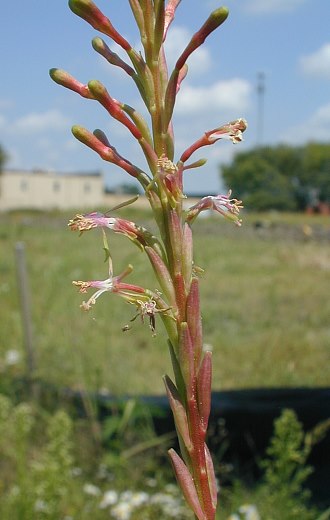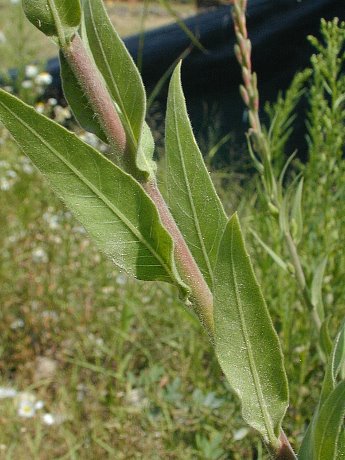 Description:
This annual or biennial wildflower is 2-6' tall and either unbranched
or sparingly branched. The central stem is light green to reddish
brown, terete (round in cross-section), and covered with fine
hairs. Ascending alternate leaves occur along the lower to
middle sections of the stem. Individual leaves are 2-5" long and ¼-1"
across; they are
narrowly lanceolate to lanceolate, sessile (or nearly so), and either
entire (smooth) or sparsely denticulate with barely perceptible
teeth. Leaf surfaces are light gray-green and either glabrous or
sparsely to moderately covered with appressed fine hairs. Leaf venation
is pinnate. The upper stem (or stems) terminates in a narrow spike of
flowers about ½-2½' long. Only a few flowers are in bloom at the same
time, beginning at the bottom of the spike and ending at its apex. Each
flower is about ¼" across, consisting of 4 spreading petals, 4 drooping
sepals, an inferior ovary, 8 stamens, and a single style with an
X-shaped stigma. The petals are white, pink, or magenta (often becoming
more deeply colored with age); they are oblanceolate in shape. The
sepals are light green to red and linear-lanceolate. The ovary
is light green to red and narrowly cylindrical. The central
stalk of the floral
spike is light green to red and glabrous. The blooming period occurs
during the summer and lasts about 2 months. The flowers open during the
evening and close during the morning. However, on cloudy days, they may
remain open later. Each flower lasts only 1-2 days. In the absence
of cross-pollination, the flowers are self-fertile. They are replaced
by ellipsoid seed capsules that become about 1/3" (9 mm.) in length at
maturity. Each capsule contains 2-4 seeds about 2-3 mm. in length that
are lanceoloid and somewhat flattened. The root system consists of a
stout taproot.
Description:
This annual or biennial wildflower is 2-6' tall and either unbranched
or sparingly branched. The central stem is light green to reddish
brown, terete (round in cross-section), and covered with fine
hairs. Ascending alternate leaves occur along the lower to
middle sections of the stem. Individual leaves are 2-5" long and ¼-1"
across; they are
narrowly lanceolate to lanceolate, sessile (or nearly so), and either
entire (smooth) or sparsely denticulate with barely perceptible
teeth. Leaf surfaces are light gray-green and either glabrous or
sparsely to moderately covered with appressed fine hairs. Leaf venation
is pinnate. The upper stem (or stems) terminates in a narrow spike of
flowers about ½-2½' long. Only a few flowers are in bloom at the same
time, beginning at the bottom of the spike and ending at its apex. Each
flower is about ¼" across, consisting of 4 spreading petals, 4 drooping
sepals, an inferior ovary, 8 stamens, and a single style with an
X-shaped stigma. The petals are white, pink, or magenta (often becoming
more deeply colored with age); they are oblanceolate in shape. The
sepals are light green to red and linear-lanceolate. The ovary
is light green to red and narrowly cylindrical. The central
stalk of the floral
spike is light green to red and glabrous. The blooming period occurs
during the summer and lasts about 2 months. The flowers open during the
evening and close during the morning. However, on cloudy days, they may
remain open later. Each flower lasts only 1-2 days. In the absence
of cross-pollination, the flowers are self-fertile. They are replaced
by ellipsoid seed capsules that become about 1/3" (9 mm.) in length at
maturity. Each capsule contains 2-4 seeds about 2-3 mm. in length that
are lanceoloid and somewhat flattened. The root system consists of a
stout taproot.Cultivation: The preference is full sun, mesic to dry conditions, and almost any kind of soil that is well-drained. Resistance to hot dry weather is excellent, although some of the lower leaves may wither away. This wildflower is somewhat weedy.
Range & Habitat: The adventive Small-Flowered Gaura is relatively uncommon in Illinois, occurring in scattered areas of the state (see Distribution Map). This wildflower is native to the Great Plains region and some western areas of the United States; it has also been found in northern Mexico. Habitats include upland prairies, abandoned fields, vacant lots, areas along railroads, and barren waste areas. Open areas with a history of disturbance are preferred.

Faunal Associations: The flowers are cross-pollinated by bees and moths. Both nectar and pollen are available as floral rewards. The foliage, flowers, and other parts of Small-Flowered Gaura and similar species are sometimes eaten by various insects, including the flea beetle Altica foliaceae, the aphid Macrosiphum pseudorosae, Hippiscus ocelote (Wrinkled Grasshopper), Melanoplus keeleri luridus (Keeler's Grasshopper), and some moth caterpillars. These moth species include Proserpinus guarae (Proud Sphinx), Proserpinus juanita (Green-Banded Day Sphinx), and Schinia gaurae (Clouded Crimson). The foliage is palatable to goats and probably other mammalian herbivores.
Photographic Location: A vacant lot in Urbana, Illinois.
Comments: This wildflower can develop narrow floral spikes of exceptional length. Even so, it is not particularly showy because only a few of the small flowers are in bloom at the same time, and this occurs primarily at night. Small-Flowered Gaura is a more columnar plant than the more common Gaura biennis (Biennial Gaura). The latter plant is more branched and its flowers are larger in size. Usually, Biennial Gaura is the taller of these two species, but the height of individual plants can vary considerably. Small-Flowered Gaura is native to prairies that are located to the west of the Mississippi River, although it has expanded its range eastward in recent decades.